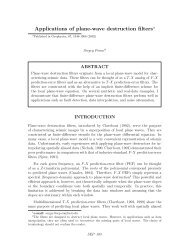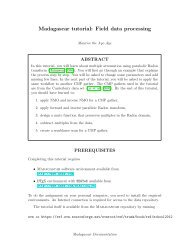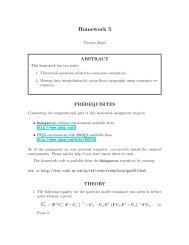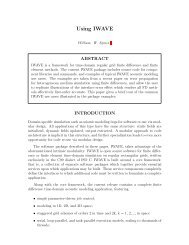Seismic wave extrapolation using lowrank symbol ... - Madagascar
Seismic wave extrapolation using lowrank symbol ... - Madagascar
Seismic wave extrapolation using lowrank symbol ... - Madagascar
You also want an ePaper? Increase the reach of your titles
YUMPU automatically turns print PDFs into web optimized ePapers that Google loves.
Fomel, Ying, & Song 2 Lowrank <strong>wave</strong> <strong>extrapolation</strong><br />
propagation, because it involves eigenfunctions rather than rows and columns of the<br />
original <strong>extrapolation</strong> matrix. Our algorithm can also be regarded as an extension<br />
of the <strong>wave</strong>field interpolation algorithm of Etgen and Brandsberg-Dahl (2009), with<br />
optimally selected reference velocities and weights. Another related method is the<br />
Fourier finite-difference (FFD) method proposed recently by Song and Fomel (2011).<br />
FFD may have an advantage in efficiency, because it uses only one pair of multidimensional<br />
forward and inverse FFTs (fast Fourier transforms) per time step. However, it<br />
does not offer flexible controls on the approximation accuracy.<br />
Our approach to <strong>wave</strong> <strong>extrapolation</strong> is general and can apply to different types of<br />
<strong>wave</strong>s, including both acoustic and elastic seismic <strong>wave</strong>s, as well as velocity continuation<br />
(Fomel 2003b), offset continuation (Fomel 2003a), prestack exploding reflector<br />
<strong>extrapolation</strong> (Alkhalifah and Fomel 2010), etc.<br />
The paper is organized as follows. We first present the theory behind the proposed<br />
algorithm, then describe the algorithm and test its accuracy on a number of synthetic<br />
benchmark examples of increasing complexity.<br />
WAVE EXTRAPOLATION<br />
Let P (x, t) be the seismic <strong>wave</strong>field at location x and time t. The <strong>wave</strong>field at the<br />
next time step t + ∆t can be approximated by the following mixed-domain operator<br />
(Wards et al. 2008)<br />
∫<br />
P (x, t + ∆t) = ̂P (k, t) e i φ(x,k,∆t) dk , (1)<br />
where ̂P (k, t) is the spatial Fourier transform of P (x, t)<br />
̂P (k, t) = 1 ∫<br />
P (x, t)e −i k·x dx , (2)<br />
(2 π) 3<br />
where k is the spatial <strong>wave</strong>number. To define the phase function φ(x, k, t), which<br />
appears in equation (1), one can substitute approximation (1) into the <strong>wave</strong> equation<br />
and extract the geometrical (high-frequency) asymptotic of it. In case of seismic <strong>wave</strong><br />
propagation, this leads to the eikonal-like equation<br />
∂φ<br />
∂t<br />
= ±V (x, k) |∇φ| , (3)<br />
where V (x, k) is the phase velocity, and the choice of the sign corresponds, in the<br />
case of a point source, to expanding or contracting <strong>wave</strong>s. In the isotropic case, V<br />
does not depend on k. The initial condition for equation (3) is<br />
φ(x, k, 0) = k · x , (4)<br />
which turns equation (1) into the simple inverse Fourier transform operation.











